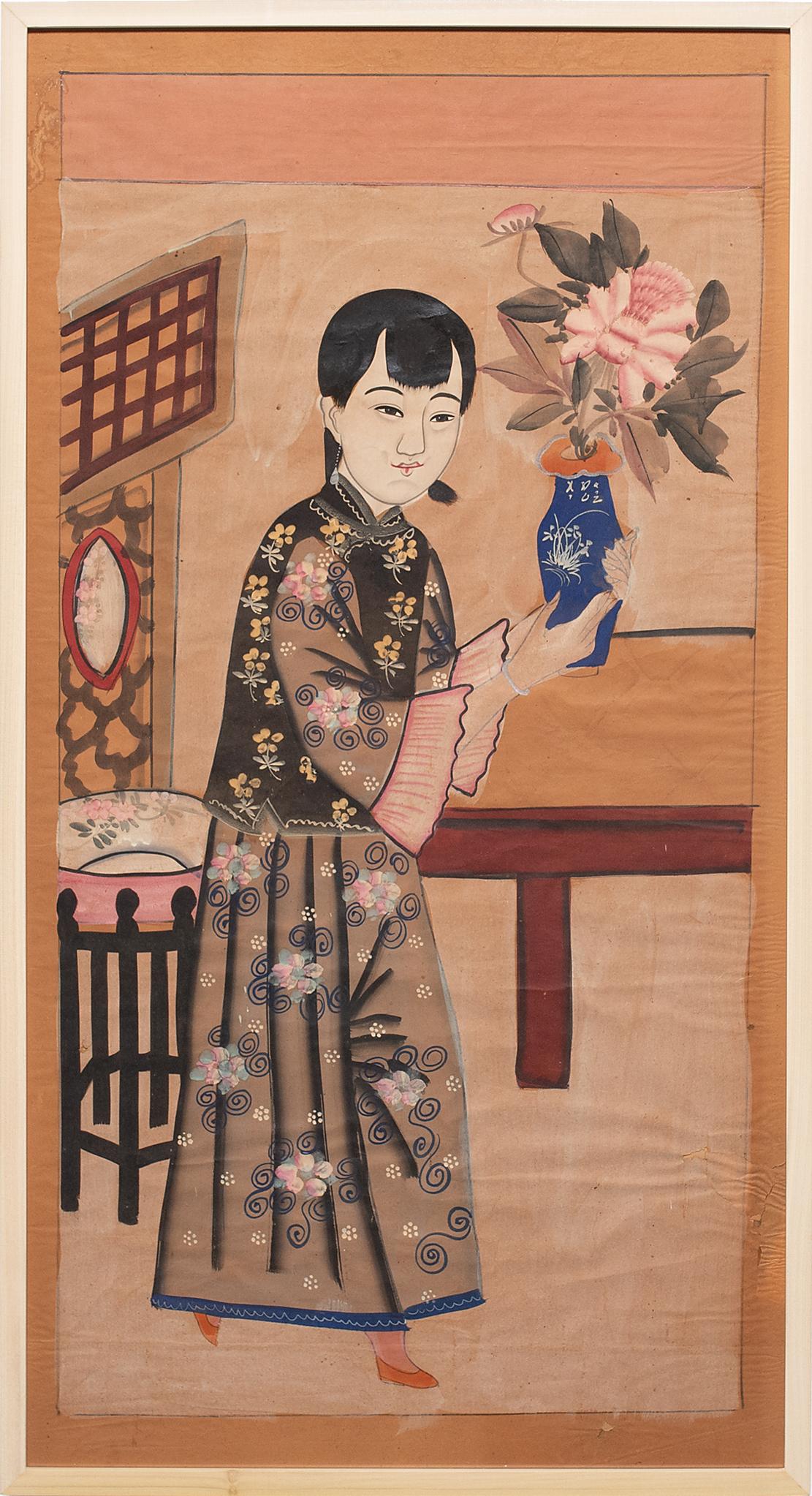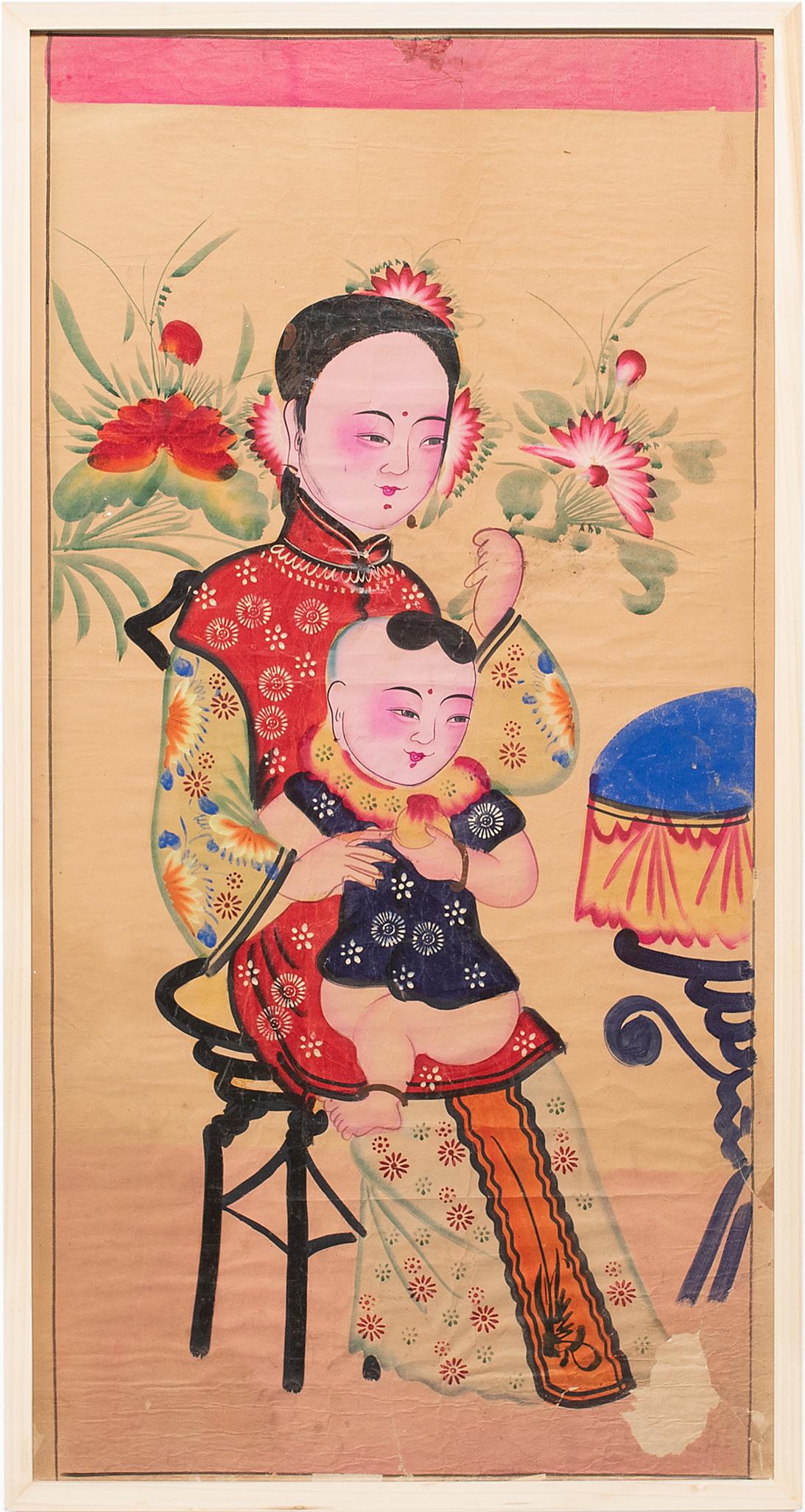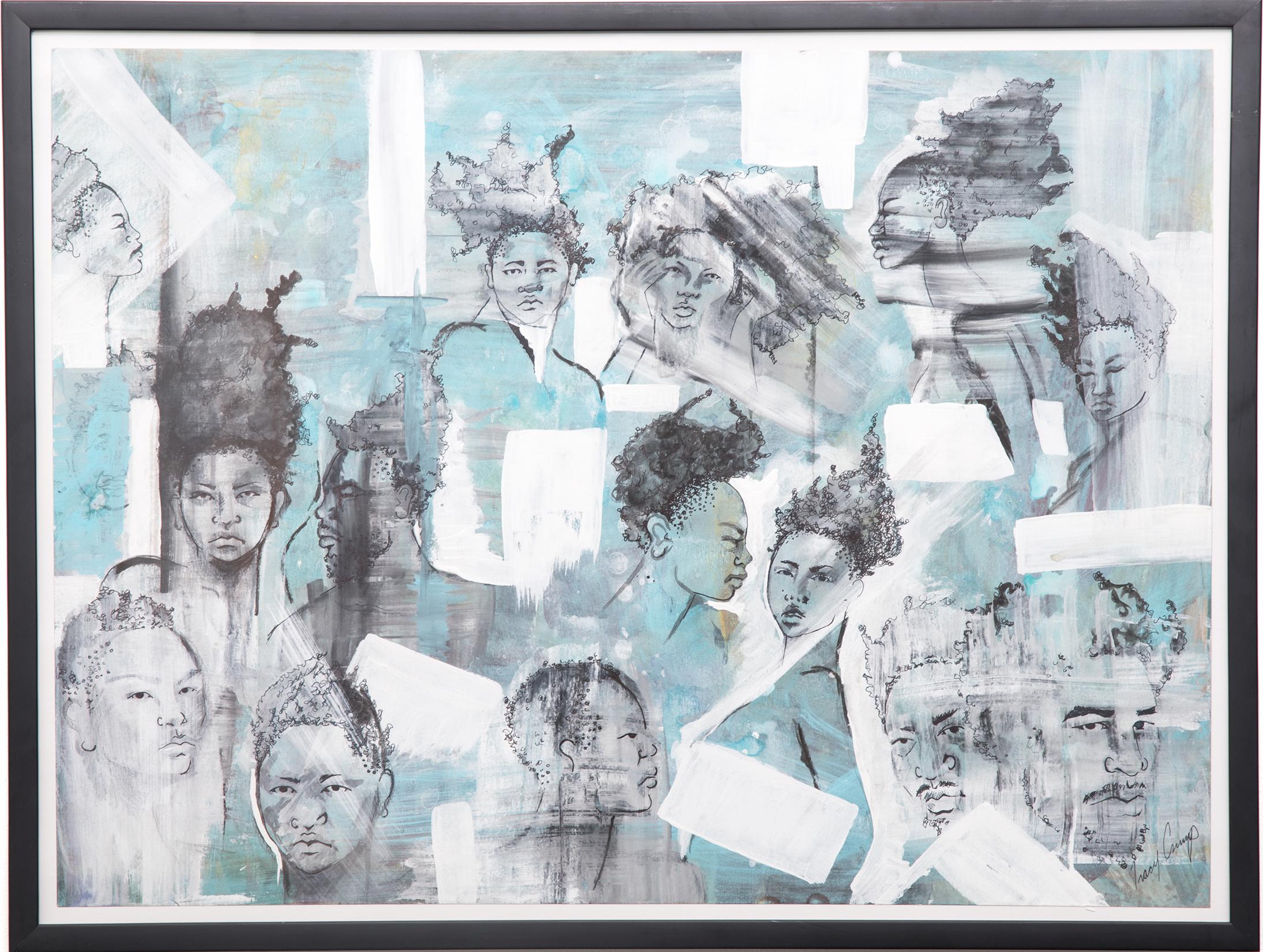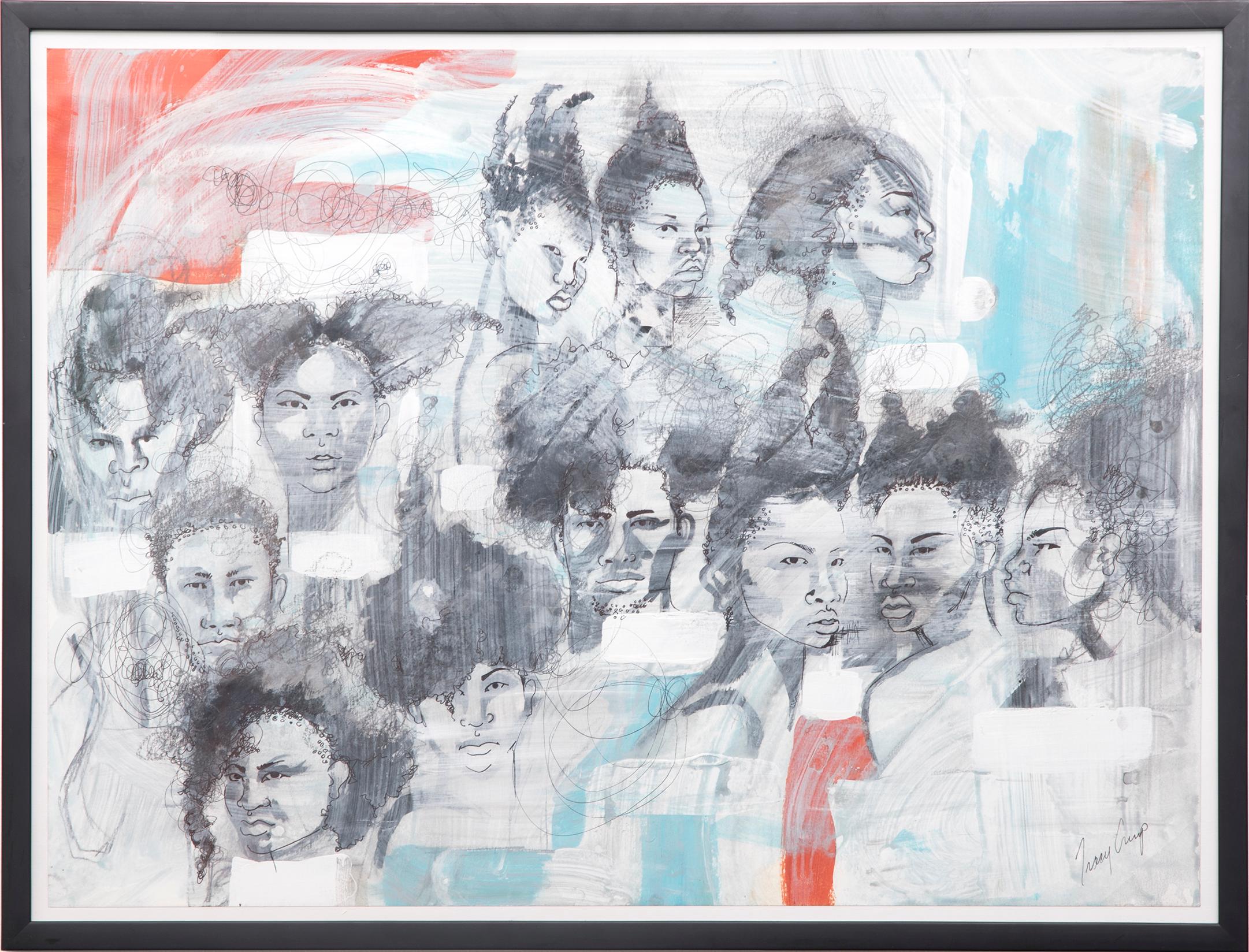Items Similar to Korean Buddhist Guardian Mural Taenghwa Painting, c. 1800
Want more images or videos?
Request additional images or videos from the seller
1 of 7
UnknownKorean Buddhist Guardian Mural Taenghwa Painting, c. 1800c. 1800
c. 1800
About the Item
Evolving from the Korean tradition of tomb mural painting came the Buddhist practice of “taenghwa,” or hanging-painting, a form of religious painting that included hanging scrolls, framed paintings and wall murals. Influenced by Chinese and Central Asian Buddhist art, taenghwas were painted with Buddhist iconography and were used in Buddhist temples as visual aids during rituals and meditation. The earliest surviving examples of taenghwa date to the early 13th century and were composed of silk gauze and mineral colors. These paintings would portray images of prominent Buddhas and bodhisattvas or depict stories from Buddhist scripture. This example dates to the later Joseon dynasty (1392-1910), a period wherein the presiding Confucian government gradually suppressed Buddhist institutions, resulting in a stylistic shift in taenghwa painting towards brighter colors, smaller scales and simpler materials.
This example is a form of shinjung taenghwa (신중탱화), which loosely translates to “altar painting of guardian deities,” or “guardian mural” for short. The central figure, wearing a feathered headdress and illuminated by a halo, is Tongjin Posal, or Skanda, a bodhisattva charged with protecting the Lotus Sutra of the True Law, one of the most revered of all Mahāyāna Buddhist texts. Typically placed above the middle altar of a Buddhist temple, the shinjung taenghwa houses the lesser deities and Tongjin Posal is commonly positioned in the center as their defender. The figures surrounding Tongjin Posal are various heavenly gods and goddesses who together comprise the sinjung, or Host of Spirits. Painted with gouache pigments in a dark palette of red, green, brown and blue, this taenghwa is a beautiful example of this traditional art form, composed with incredible movement, intricate detailing and rich symbolism.
Gouache paint on cotton. Framed.
Significant fading due to age. Some creasing.
- Creation Year:c. 1800
- Dimensions:Height: 42 in (106.68 cm)Width: 42 in (106.68 cm)Depth: 1 in (2.54 cm)
- Medium:
- Movement & Style:
- Period:
- Condition:
- Gallery Location:Chicago, IL
- Reference Number:
About the Seller
5.0
Diamond Seller
These expertly vetted sellers are 1stDibs' most experienced sellers and are rated highest by our customers.
1stDibs seller since 2018
26 sales on 1stDibs
- ShippingRetrieving quote...Ships From: Chicago, IL
- Return PolicyA return for this item may be initiated within 2 days of delivery.
More From This SellerView All
- Yangliuqing Peace & Prosperity New Year Painting, c. 1920Located in Chicago, ILChinese New Year paintings (nian hua) are colorful folk paintings created to celebrate the annual Spring Festival. Drawn or printed by folk artists in regional studios, nian hua paintings featured exaggerated characters with bright and contrasting colors. Put up around the home to beckon luck and happiness in the coming year, most paintings depicted mythical guardians, scenes from folk operas, or auspicious symbols of good luck. This New Year painting depicts a young woman holding a vase filled with peony blossoms. This combination of motifs is a visual idiom for "may you have peace and prosperity" (ping'an fu gui). The early 20th century painting is from the town of Yangliuqing, one of the leading producers of traditional New Year's paintings known for its combination of woodblock printing...Category
Early 20th Century Folk Art Figurative Paintings
MaterialsPaper, Ink, Pigment
- Yangliuqing Longevity New Year Painting, c. 1920Located in Chicago, ILChinese New Year paintings (nian hua) are colorful folk paintings created to celebrate the annual Spring Festival. Drawn or printed by folk artists in regional studios, nian hua pain...Category
Early 20th Century Folk Art Figurative Paintings
MaterialsInk, Pigment, Paper
- Chinese Yangliuqing New Year Painting of Beauty and Baby, c. 1920Located in Chicago, ILChinese New Year paintings (nian hua) are colorful folk paintings created to celebrate the annual Spring Festival. Drawn or printed by folk artists in regional studios, nian hua paintings featured exaggerated characters with bright and contrasting colors. Put up around the home to beckon luck and happiness in the coming year, most paintings depicted mythical guardians, scenes from folk operas, or auspicious symbols of good luck. This New Year painting depicts a young woman with a child and is hand-painted in a palette of red, blue, and purple. Belonging to a genre known as 'beauties and babies,' the painting represents a harmonious family life. The early 20th century painting is from the town of Yangliuqing, one of the leading producers of traditional New Year's paintings known for its combination of woodblock printing...Category
Early 20th Century Folk Art Figurative Paintings
MaterialsPaper, Ink, Pigment
- 'The People People 2, " Acrylic Paint on Canvas, 2006Located in Chicago, ILIn this series entitled "The People People," Tracy Crump uses washes of grey, white and aqua to both conceal and reveal sensitively drawn figures. Each figure stands alone as an indi...Category
21st Century and Contemporary Outsider Art Figurative Drawings and Water...
MaterialsPaper, Ink, Acrylic, Watercolor
- "The People People 4, " Acrylic Paint and Watercolor on Paper, 2006Located in Chicago, ILIn this series entitled "The People People," Tracy Crump uses washes of grey, white and aqua to both conceal and reveal sensitively drawn figures. Each figure stands alone as an indi...Category
21st Century and Contemporary Outsider Art Figurative Drawings and Water...
MaterialsPaper, Ink, Acrylic, Watercolor
- "The People People 6" by Tracy CrumpLocated in Chicago, ILIn this series entitled "The People People," Tracy Crump uses washes of white, red and aqua to both conceal and reveal sensitively drawn figures. Each fig...Category
21st Century and Contemporary Outsider Art Figurative Drawings and Water...
MaterialsPaper, Ink, Acrylic, Watercolor
You May Also Like
- "Feed Me, " Mixed Media Acrylic and Charcoal Figurative Drawing on PaperLocated in Houston, TXThis work bears striking achromatic depiction of a face, contrasted by a vibrant and colorful section of watermelon. The simplicity and levity of the watermelon helps offset the emot...Category
Early 2000s Folk Art Figurative Drawings and Watercolors
MaterialsCharcoal, Paper, Acrylic
- "A Good Witch, " Acrylic and Charcoal Mixed Media Painting on Paper in Wood FrameLocated in Houston, TXCertainly one of Bert Long’s more humorous artworks, "A Good Witch" exemplifies affection for sincerity, despite obvious levity. Bert L. Long Jr., was self...Category
1990s Folk Art Figurative Paintings
MaterialsAcrylic, Paper, Charcoal
- Malcah Zeldis Folk Art Gouache Painting Wine & Cigarettes Woman Outsider ArtistLocated in Surfside, FLMALCAH ZELDIS Reclining Woman Wine and Cigarettes gouache on paper Hand signed and dated bottom right. titled in pencil on paper verso. Matted to 13 X 1...Category
1980s Folk Art Figurative Paintings
MaterialsPaper, Gouache
- Malcah Zeldis Folk Art Gouache Painting Sports Basketball Arena Coca Cola SignLocated in Surfside, FLMALCAH ZELDIS ''Basketball'', 1988, gouache on paper Hand signed and dated bottom right, titled in pencil on paper verso Malcah Zeldis (born Mildred ...Category
1980s Folk Art Figurative Paintings
MaterialsPaper, Gouache
- Malcah Zeldis Folk Art Gouache Painting Outsider Circus Trapeze Artist AcrobatsLocated in Surfside, FLMALCAH ZELDIS Circus, Trapeze Artists and Acrobats gouache on paper Hand signed and dated bottom right. titled in pencil on paper verso. Framed to 15 X ...Category
1980s Folk Art Figurative Paintings
MaterialsPaper, Gouache
- Malcah Zeldis Folk Art Gouache Painting Outsider Circus Trapeze Horse AcrobatsLocated in Surfside, FLMALCAH ZELDIS Circus, Trapeze Artists, Horse rider and Acrobats gouache on paper Hand signed and dated bottom right. titled in pencil on paper verso. Fr...Category
1980s Folk Art Figurative Paintings
MaterialsPaper, Gouache
Recently Viewed
View AllMore Ways To Browse
19th C Paintings
Buddhist Art
19th C Painting Frames
Dark House Painting
Chinese House Painting
Korea Wall Art
Korean Wall Art
Antique Religious Paintings
Korean Blue
Asian Buddhist Art
Antique Buddhist
Buddhist Antique
Buddhist Painting
Antique Buddhist Art
Antique Murals
Altar Painting
Antique Hanging Scroll
Early 13th Century





